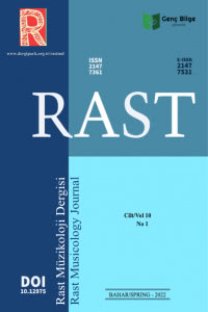Improvization as a factor of compository and performance interpretation of modern instrumental music (on the example of “Solo-Solissimo” for violin by K. Tsepkolenko)
The purpose of the work is to study the mechanisms of formation of the composer's language on the example of modern instrumental music and to determine the relationship between the composer's plan and the interpretive-performing view of the author's text. Interpretive-performing and comparative analytical approaches in combination with the source method allow identifying the ratio of stable and mobile elements of the author's work, as well as distinguishing between composer's and performer's interpretation of the work. The scientific novelty of the work is the comparative analysis of K. Tsepkolenko's work "Solo-Solissimo №1" for solo violin, as well as the performance versions of this work considered for the first time in the text of the work. The considered performance versions represent two different interpretive approaches to the analyzed work. In Carmella Tsepkolenko's "Solo Solissimo" by Peter Shepard Skaverd, the figure of the performer is felt more than the personality of the composer. This attitude is formed through the free handling of the text in those segments where it is not provided by the author, as well as through the use of their own intonation material at the time of improvisation. Dan Auerbach and Myroslava Kotorovych set the task to convey the author's model of the text, using the composer's intonation material in the improvisational fragment. Thus, improvisation in the considered work is an integral part of the compositional and performing sphere of musical expression. It is thanks to the performer's improvisational skill that the work is filled with content, its genre and style identification from lyrical and philosophical color to dramatic and expressive sphere. The performance of "Solo-solissimo" requires great skill from the violinist, not only technical virtuosity, but also mental, that is required by the author's compositional concept, which is the program basis of the composition. We believe that the intention of this work is, above all, to represent the stylistic competencies of the performer as an unleashed actor-improviser.
Improvization as a factor of compository and performance interpretation of modern instrumental music (on the example of “Solo-Solissimo” for violin by K. Tsepkolenko)
The purpose of the work is to study the mechanisms of formation of the composer's language on the example of modern instrumental music and to determine the relationship between the composer's plan and the interpretive-performing view of the author's text. Interpretive-performing and comparative analytical approaches in combination with the source method allow identifying the ratio of stable and mobile elements of the author's work, as well as distinguishing between composer's and performer's interpretation of the work. The scientific novelty of the work is the comparative analysis of K. Tsepkolenko's work "Solo-Solissimo №1" for solo violin, as well as the performance versions of this work considered for the first time in the text of the work. The considered performance versions represent two different interpretive approaches to the analyzed work. In Carmella Tsepkolenko's "Solo Solissimo" by Peter Shepard Skaverd, the figure of the performer is felt more than the personality of the composer. This attitude is formed through the free handling of the text in those segments where it is not provided by the author, as well as through the use of their own intonation material at the time of improvisation. Dan Auerbach and Myroslava Kotorovych set the task to convey the author's model of the text, using the composer's intonation material in the improvisational fragment. Thus, improvisation in the considered work is an integral part of the compositional and performing sphere of musical expression. It is thanks to the performer's improvisational skill that the work is filled with content, its genre and style identification from lyrical and philosophical color to dramatic and expressive sphere. The performance of "Solo-solissimo" requires great skill from the violinist, not only technical virtuosity, but also mental, that is required by the author's compositional concept, which is the program basis of the composition. We believe that the intention of this work is, above all, to represent the stylistic competencies of the performer as an unleashed actor-improviser.
___
- Epstein, M. (2008). Collective improvisation: creativity through communication. Part two. Topos theory. Literary and Philosophical Journal. http://www.topos.ru/article/6530
- Kholopov, Y. (1982). Changing and unchanging in the evolution of musical thinking. Problems of Tradition and Innovation in Contemporary Music. Moscow: Soviet Composer. http://www.kholopov.ru/izm/
- Maidenberg-Todorova, K.I. (2013). Composer and performing interpretative properties of aleatory-sonoristic composition. Art and Education, 5, 32-41.
- Saponov, M. (1996). Minstrels. Essays on the Musical Culture of the Western Middle Ages. Moscow: Prest.
- Serdyukov, A. (2017). Traditions of improvisation in modern academic musical culture. Dissertation of PhD in arts. 17.00.02. Rostov on Don.
- Zavgorodnyaya, G. (2013). Polyphony as a fundamental basis of musical thinking: to the methodology of musicological analysis: dissertation, PhD in arts. 17.00.03: Musical art. Kiev.
